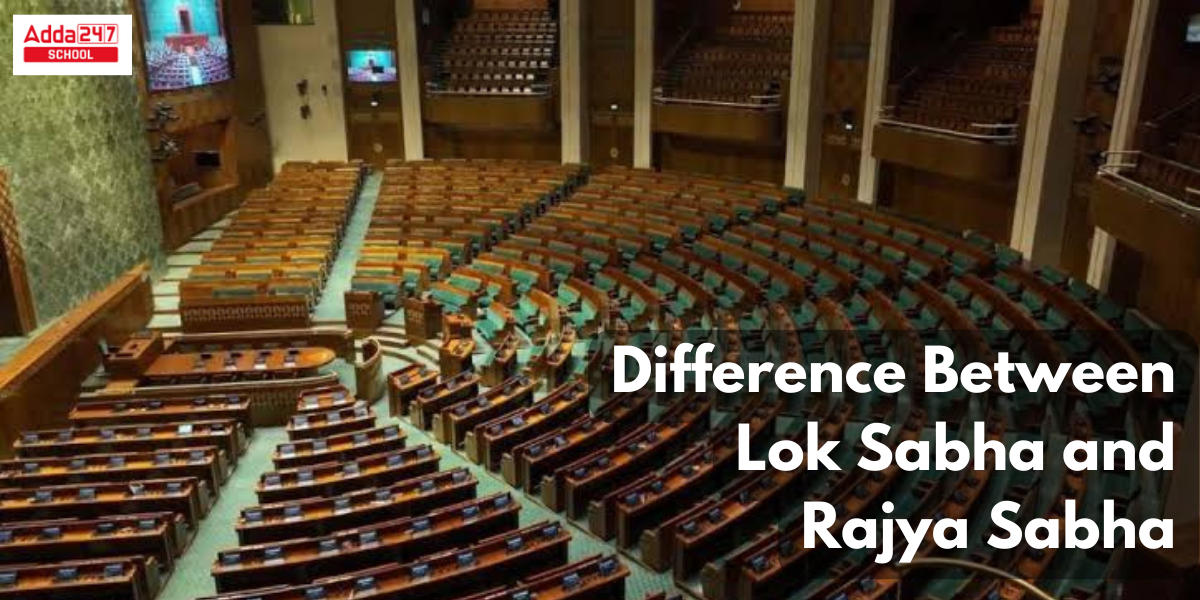Table of Contents
Difference Between Lok Sabha and Rajya Sabha: India has a legislature with a bicameral structure known as Parliament. The Lower House and Upper House are the two bodies of the Indian Parliament. The Lower House, known as the Lok Sabha or the House of People, and the Upper House, known as the Rajya Sabha or the Council of States. These two institutions collaborate to bring about legislative modifications in the country. The terms ‘Lok Sabha’ and ‘Rajya Sabha’ were first used in Indian politics in 1954. While there are certain parallels between the Lok Sabha and the Rajya Sabha, there are also significant differences that every Indian citizen should be aware of. The crucial Difference Between Lok Sabha and Rajya Sabha are comprehensively discussed in this article.
Difference Between Lok Sabha and Rajya Sabha
Articles 79 to 122 of the Indian Constitution are addressed by the laws of the Indian Parliament. In many ways, the two parliamentary houses are diametrically opposed. To provide applicants with a full understanding, we have covered all of the unique traits and comparisons between these two chambers in this section of this post. To gain a deeper understanding, you should first comprehend what is the difference between lok sabha and rajya sabha.
What is Lok Sabha?
The Lok Sabha is also known as the House of the People. By passing bills here, it performs a crucial role in enacting laws in India. Every five years, the Lok Sabha elections are held. Its primary role is to ensure that the government functions honestly. India held its seventeenth Lok Sabha general election in 2019. The Lok Sabha’s Lower House has a total of 552 members.
Seating arrangements In Lower House / Lok Sabha
- The states are represented by 530 members. The Union Territories are represented by 20 people.
- Furthermore, the president suggests two contenders from the Anglo-Indian diaspora.
- Since only 13 members were chosen to serve the Union Territories, the total number of members is 545.
- Following the passage of the 104th Constitutional Amendment Act of 2019, two Anglo Indians weren’t nominated for the Lok Sabha.
What is Rajya Sabha?
The Rajya Sabha is referred to as the Council of States. The Council of states is the perennial house of parliament and cannot be dissolved under any circumstances. It is crucial to build a legislature with a bicameral structure in India. In response to the Central Legislature, it preserves the rights of Indian states. In contrast to Lok Sabha members, Rajya Sabha members are elected for a six-year term. Every other year, one-third of the Rajya Sabha’s members retire. The Rajya Sabha’s Upper House has 250 members.
Seating arrangements In Upper House / Rajya Sabha
- States and Union Territories get represented by 238 indirectly elected members.
- The President appoints twelve members.
- The current membership is 245 people, including 233 from states and UTs and 12 from nominations.
Difference Between Rajya Sabha and Lok Sabha
The Indian political system is federalist in nature, which implies that the government is divided into two parts. The Union Government and the State Government are the two sections. Bicameralism dates back to 1919 when the Government of India Act was passed. The Parliament is made up of the Lok Sabha and Rajya Sabha, as well as the President. Powers have been delegated to both houses. But there is a minor difference in their abilities.
Difference Between Rajya Sabha and Lok Sabha- Which House is more powerful?
The Lok Sabha has greater authority than the Rajya Sabha. Read the following points to make it clearer.
- The Lok Sabha can express dissatisfaction with the government in ways that the Rajya Sabha cannot.
- By failing to pass a motion to thank the President for his inaugural address
- By rejecting a money bill
- Overcoming the government on a critical issue
- However, by passing a censure or adjournment motion, Rajya Sabha can criticize the government’s actions and policies.
- Money Bills can only be introduced in Lok Sabha under Article 110. In the event of a combined session of both houses, the Lok Sabha having the greater number of members invariably wins.
- The Speaker of the Lok Sabha determines whether bills are Money Bills, whereas the Chairman of the Rajya Sabha does not have this authority.
- Only the Lok Sabha can introduce a Financial Bill under Article 110 (1).
- In terms of the union budget, Rajya Sabha is able to debate it and cannot vote on grant requests.
Difference Between Loksabha and Rajyasabha in Points
The table below outlines the key differences between Loksabha and Rajyasabha in points or upper and lower houses of Parliament.
| Difference between Loksabha and Rajyasabha | ||
| Pointers | Lok Sabha | Rajya Sabha |
| Full Name | House of People |
Council of States
|
| Definition | It is characterized as the lower house or house of people, where legislation is enacted and laws are formed to improve India’s governance. |
It is characterized as the higher house of the parliament or council of states that defends the rights of several states.
|
| Tenure of the house | It will last 5 years. It can be dissolved earlier if a no-confidence motion is passed. |
It is a permanent institution.
|
| Who heads the house? | Speaker |
Vice President of India
|
| What is the minimum age to become a member of Loksabha / Rajyasabha? | 25 years | 30 years |
| Election for Membership | The members of the Lok Sabha are elected through the voting process with the involvement of the common people. |
The members of the Rajya Sabha are elected by the representatives of state legislative assemblies of states and union territories.
|
| Total Member | 552 members |
250 members
|
| Importance | Most bills begin in Lok Sabha and are sent back to Lok Sabha for approval after passing through Rajya Sabha. It is very important in legislation. |
The Rajya Sabha has particular powers to protect the interests of the states against the Union.
|
Differentiate Between Lok sabha and Rajya sabha Functions
What are the functions of Lok Sabha?
The legislative authority of the Lok Sabha
The Lok Sabha has the authority to pass legislation impacting states and union territories. In an emergency, a bill passed by two-thirds of the members of parliament is only enforceable for one year. Aside from money bills, other bills can be approved by either the Rajya Sabha or the Lok Sabha.
Financial Concerns
Lok Sabha members introduce Money Bills. When a bill is passed by the Lok Sabha, it is sent to the Rajya Sabha for endorsement and suggestions. If MPs of the Lok Sabha agree to the suggested changes, the measure would be accepted by both chambers of parliament. The Rajya Sabha has 14 days to make the suggested changes.
Public Authorities
Members of the Lok Sabha are generally chosen members with the authority to discuss and debate a variety of subjects of common interest. Money, government expenditures, and other topics may be discussed in the Parliamentary House. The conversations and debates in parliament serve as an oversight of Indian politics.
Elections
Elections Article 54 of the Indian Constitution fulfills several purposes in terms of elections. The Lok Sabha elects its own speaker, who is also a lower house member.
What are the functions of the Rajya Sabha?
Legislative Authority of Rajya Sabha
To pass normal laws (apart from money bills), the Rajya Sabha has the same authority as the Lok Sabha. Furthermore, a bill won’t become law unless it has been adopted by both Houses.
Financial Influence
The Rajya Sabha has less control over budgets than the Lok Sabha. If the Rajya Sabha fails to pass a Money Bill 14 days after receiving it for assessment, Parliament is presumed to have adopted the bill. The irresponsibility of the Rajya Sabha is immaterial in this case. Even if Rajya Sabha sends the bill to Lok Sabha with specific modifications, the final call on whether to approve or reject the proposed amendment remains completely with Lok Sabha.
Executive Authority
According to Article 75(3) of the Indian Constitution, the Lok Sabha, not the Rajya Sabha, is the unified accountable body of the Council of Ministers. Even though it cannot dissolve the Council of Ministers, the Rajya Sabha has considerable power over the ministers.
If the majority party in the Lok Sabha chooses or elects a member as its leader, the Prime Minister may now come from the Rajya Sabha.
It consists of criticizing their practices, bringing up new issues, and initiating adjournment motions. Several of the ministers may also come from the Rajya Sabha.
Lok Sabha and Rajya Sabha Difference
Lok Sabha and Rajya Sabha are two key houses of the Indian Parliament, and they have several differences in terms of their composition, functions, and roles in the legislative process. Here are the main differentiating factors between rajya sabha and lok sabha:
- Composition:
- Lok Sabha: Lok Sabha, also known as the House of the People, is the lower house of Parliament. Its members are directly elected by the people of India through general elections. The total number of members in Lok Sabha is fixed at 545, with 543 elected members and 2 nominated members from the Anglo-Indian community.
- Rajya Sabha: Rajya Sabha, also known as the Council of States, is the upper house of Parliament. Its members are not directly elected by the public. Instead, they are elected by the elected members of State Legislative Assemblies, and by the members of the Electoral College in Union Territories. Rajya Sabha can have a maximum of 250 members, of which 12 members are nominated by the President for their expertise in various fields.
- Representation:
- Lok Sabha represents the people of India, and members are elected from various constituencies across the country.
- Rajya Sabha represents the states and Union Territories of India. Members from each state are elected to represent their respective states’ interests at the national level.
- Term:
- Members of Lok Sabha are elected for a term of five years.
- Members of Rajya Sabha serve a term of six years, but one-third of the members retire every two years, ensuring continuity.
- Eligibility:
- To be eligible for Lok Sabha, a person must be at least 25 years old and an Indian citizen.
- To be eligible for Rajya Sabha, a person must be at least 30 years old and an Indian citizen.
- Role and Functions:
- Lok Sabha plays a more dominant role in the legislative process, especially in matters related to finance and budgeting. Money bills can only be introduced in Lok Sabha.
- Rajya Sabha acts as a revising chamber and reviews legislation proposed by Lok Sabha. It can suggest amendments and delay bills but cannot ultimately block money bills.
- Accountability:
- Members of Lok Sabha are directly accountable to the voters in their constituencies.
- Members of Rajya Sabha are accountable to the political parties or bodies that nominated or elected them.
- Representation of Union Territories:
- Lok Sabha represents Union Territories through elected members.
- Rajya Sabha represents Union Territories through members nominated by the President.
In summary, while both Lok Sabha and Rajya Sabha are integral parts of the Indian Parliament, they have distinct roles, compositions, and functions. Lok Sabha represents the people, while Rajya Sabha represents the states and Union Territories, and they work together to enact and amend laws for the country.
What is the Difference Between Lok sabha and Rajya sabha for Class 8 Students
The main difference between the Lok Sabha and Rajya Sabha in India is their composition:
- Lok Sabha:
- Lok Sabha is the lower house of India’s Parliament.
- Members of Lok Sabha (MPs) are directly elected by the people of India through general elections.
- The number of seats in Lok Sabha is fixed at 545 (including 2 nominated members from the Anglo-Indian community), and these seats are allocated to the states and union territories based on their population.
- Members of Lok Sabha serve a term of five years, unless dissolved earlier.
- Rajya Sabha:
- Rajya Sabha is the upper house of India’s Parliament.
- Members of Rajya Sabha (Rajya Sabha MPs) are not directly elected by the public. They are elected by the elected members of the State Legislative Assemblies and by the members of an Electoral College for Union Territories.
- The number of seats in Rajya Sabha is not fixed and can vary. It is not based on population but is determined by the President of India.
- Rajya Sabha members have a term of six years, with one-third of the members retiring every two years.
So, the key difference is that Lok Sabha members are directly elected by the people of India, while Rajya Sabha members are elected by state legislators and union territory representatives. Additionally, the term of members and the method of allocating seats are different between the two houses.



 NEET Admit Card 2025 Release Date by NTA...
NEET Admit Card 2025 Release Date by NTA...
 Bse.ap.gov.in AP SSC 10th Class Results ...
Bse.ap.gov.in AP SSC 10th Class Results ...
 NEET Expected Cut Off 2025 for MBBS Coll...
NEET Expected Cut Off 2025 for MBBS Coll...










